Magic in Japan: Day 1 in Kyoto
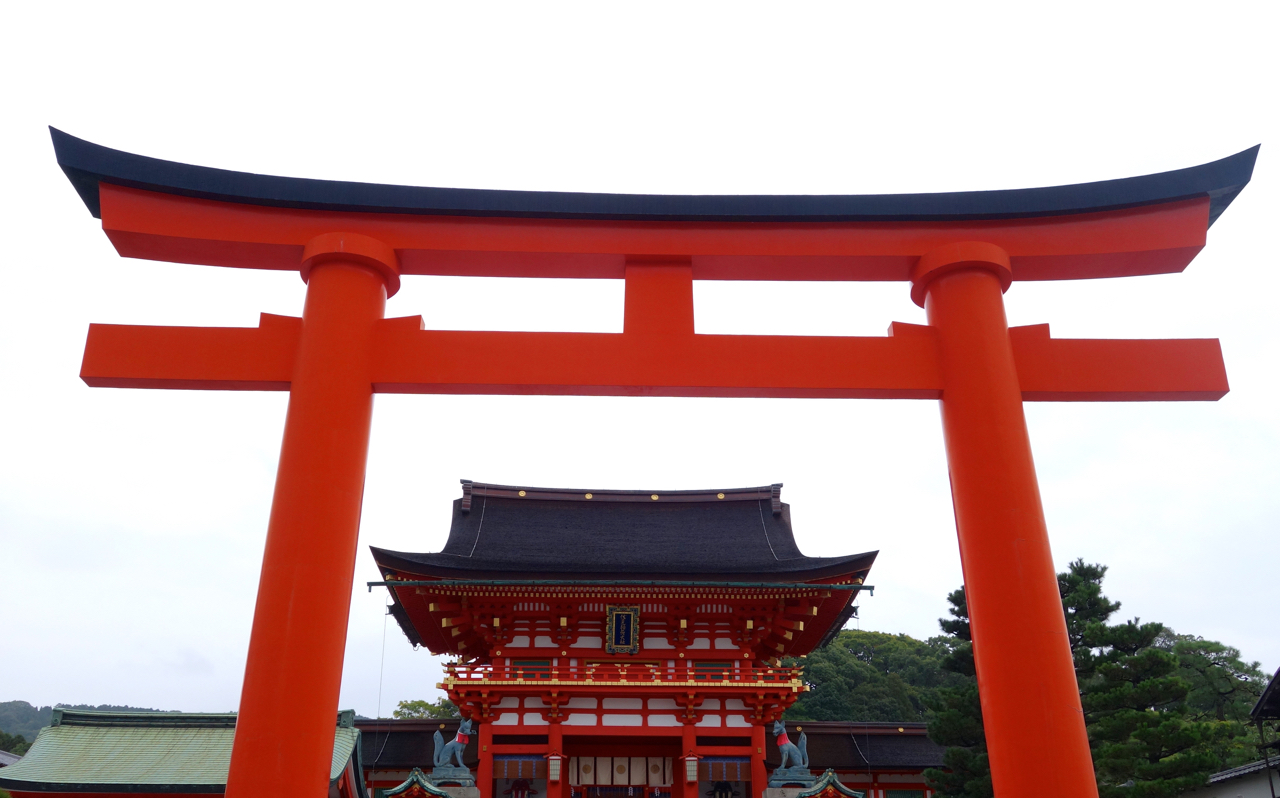
Trip Index:
Introduction
Getting There – JAL First Class
Hotel Review: Ritz-Carlton Tokyo
Guide to Tsukiji Fish Market
Room Service Review: Ritz-Carlton Tokyo
Day in Tokyo
Taking the Shinkansen “Bullet†Train
Hotel Review: Ritz-Carlton Kyoto
Tea at the Ritz-Carlton Kyoto
Day 1 in Kyoto
Day 2 in Kyoto
Room Service Review: Ritz-Carlton Kyoto
Park Hyatt Tokyo Revisited
Getting to Hiroshima
Hotel Review: Sheraton Hiroshima
Day trip to Miyajima
Day in Hiroshima
St. Regis Osaka
Food Shopping in Japan
Day in Osaka
The Ritz-Carlton Kyoto is situated in a great little neighborhood. It’s just a 10 minute walk to the center of town, and the quiet streets surrounding the hotel are quaint. Early one morning we took a walk to find some breakfast and explore the town.
The first thing that struck me was that everything was impeccably clean. I saw people come out of their homes and businesses and sweep not only the doorstep but the entire sidewalk. They picked up trash and even cleaned off common areas. It was peaceful and quiet in the early hour, punctuated only by the swishing sound of a broom or a bird calling.
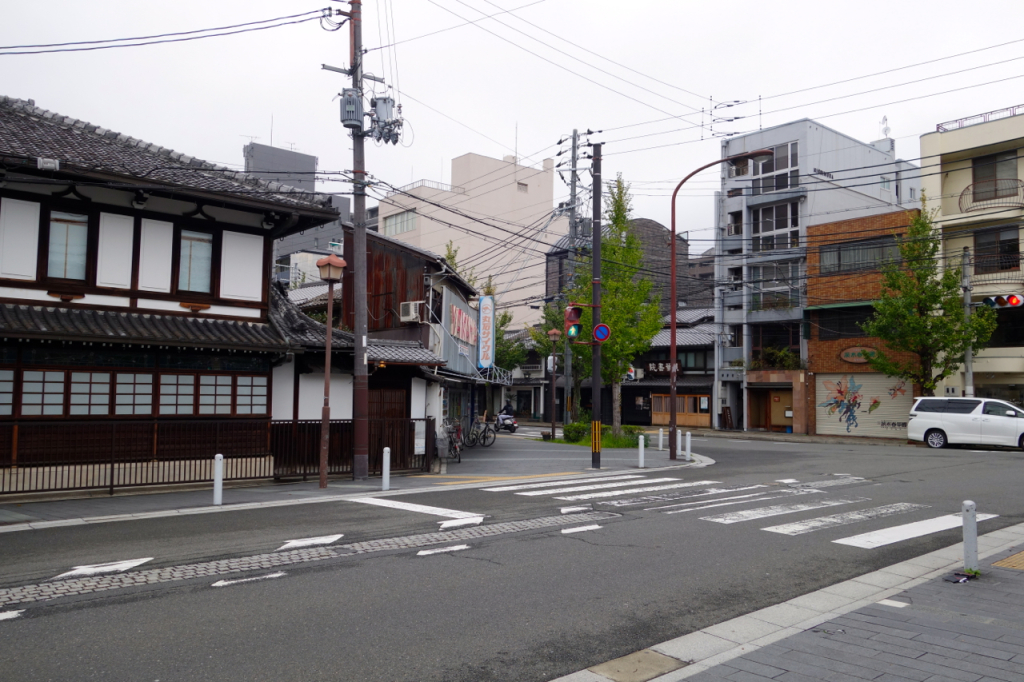
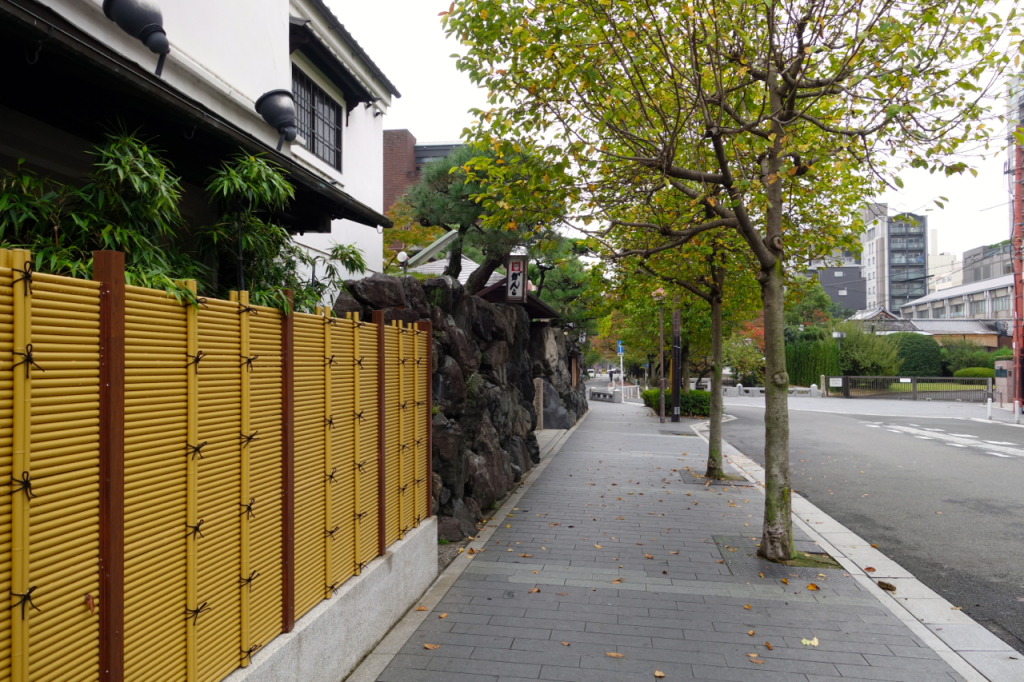
I came to a picturesque spot that warranted a stop, just a few minutes into the walk. A long boat carrying rice had been placed on a burbling stream, and the greenery seemed to invite a photo or two and a quick video.
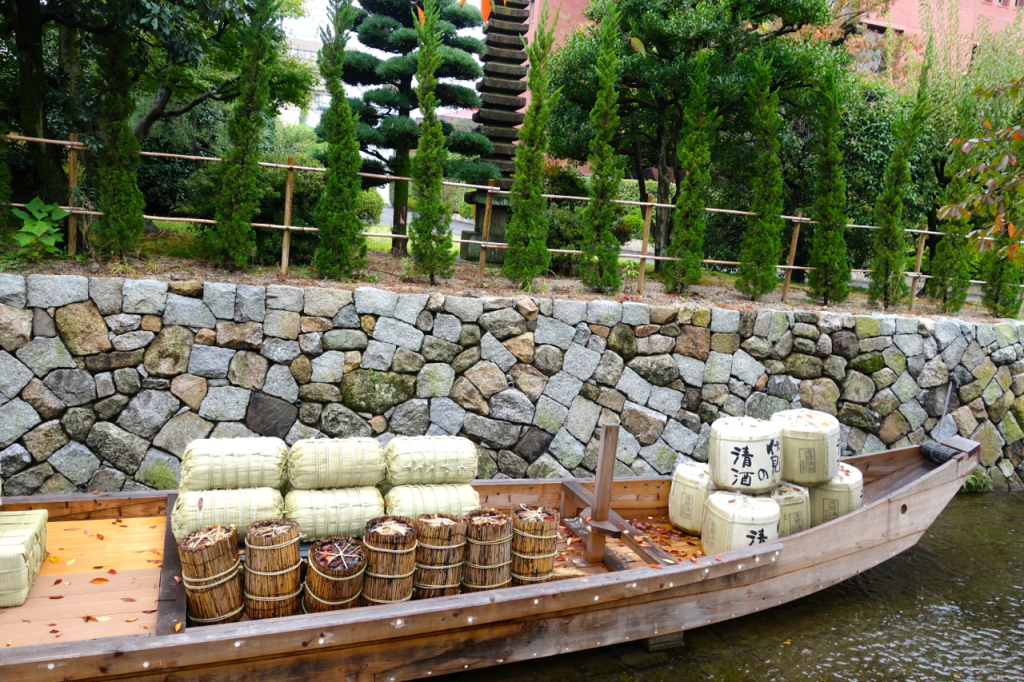
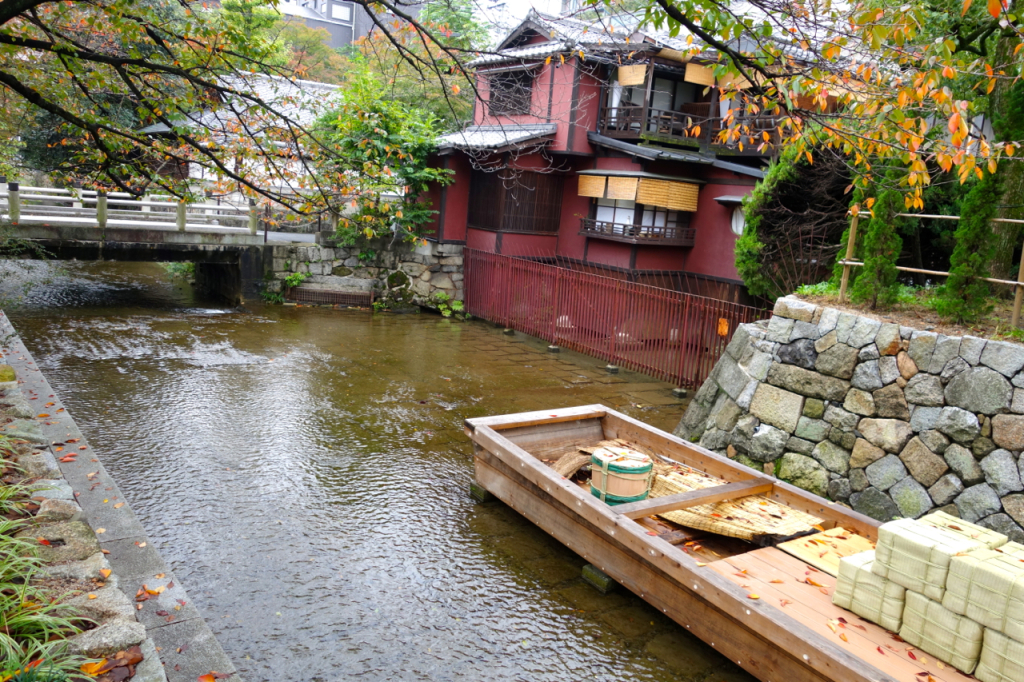
There was almost no traffic to speak of, even though the time was nearly 7am. Instead of sticking to the main street I preferred to walk through slim alleyways which offered a glimpse of some homes rather than just businesses. One alleyway had tons of potted green plants in various shapes and sizes. They were all lined up just-so, and the mismatch of colors and heights made it feel like a nursery.
Only a few minutes more and we came across a Boulangerie. The smell of freshly baked breads and pastries wafted out into the street, and I inhaled deeply. It was time to stop for breakfast.
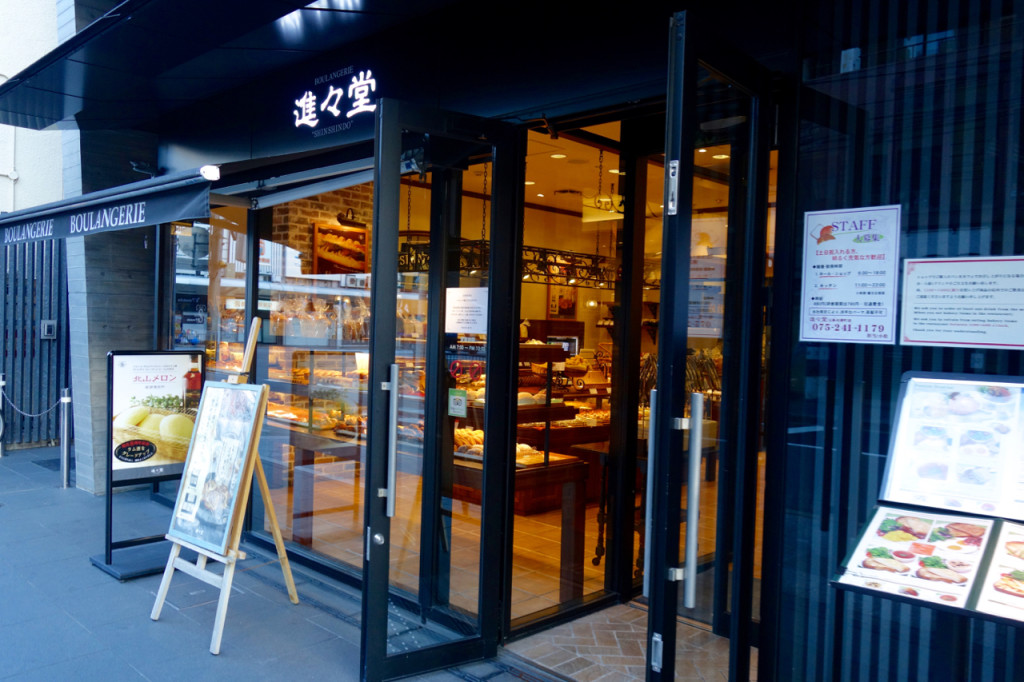
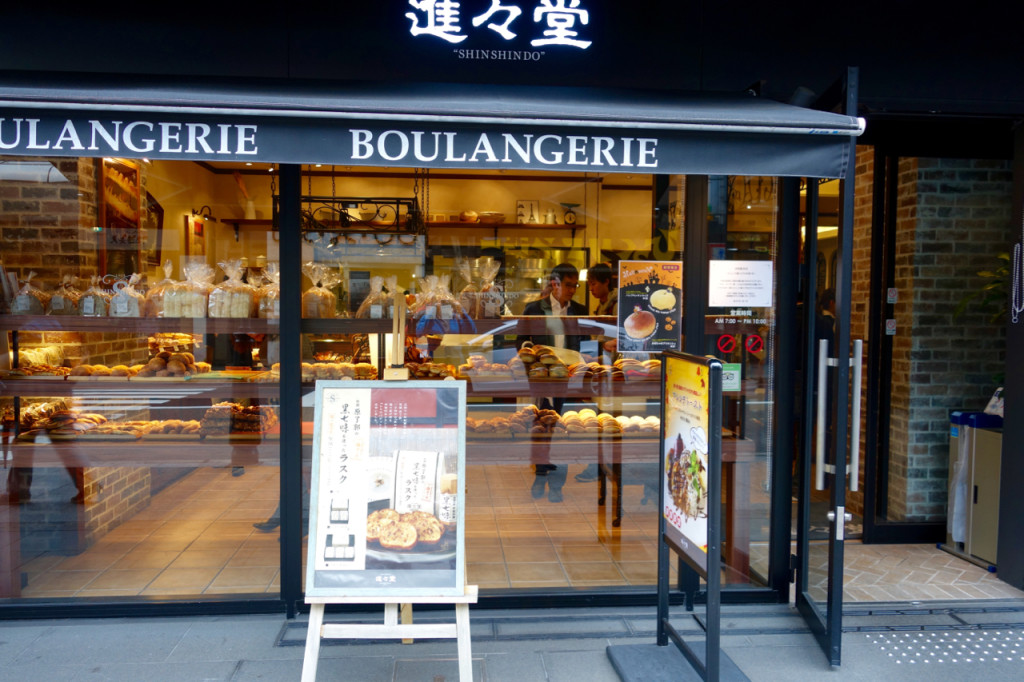
We’d stumbled across a great place to get some pastries for take-away, plus there was a restaurant too. Jackpot!
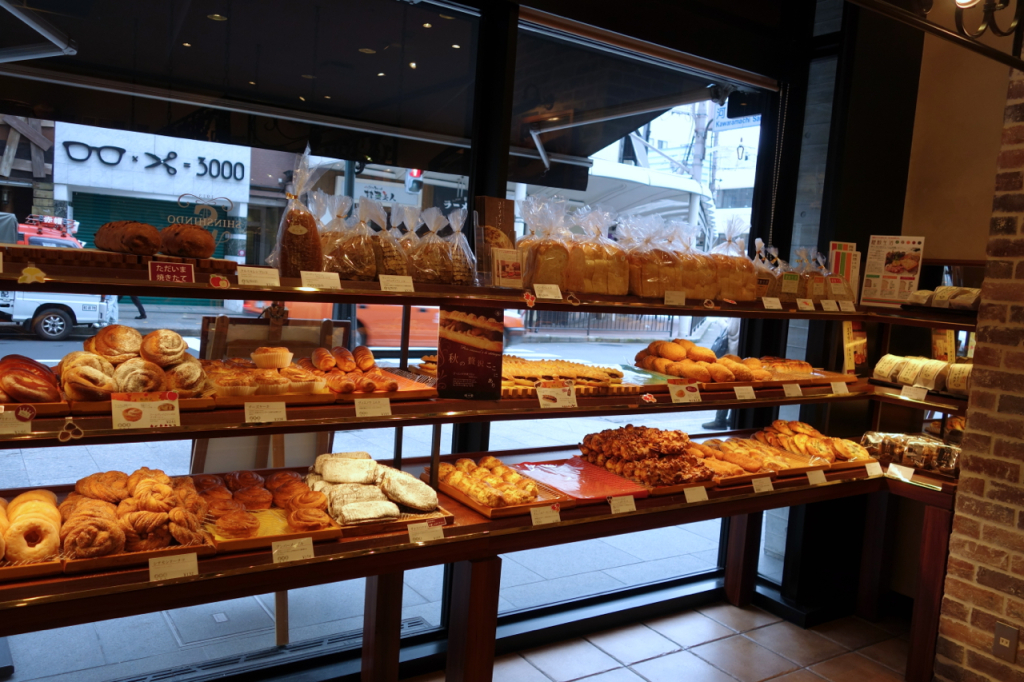
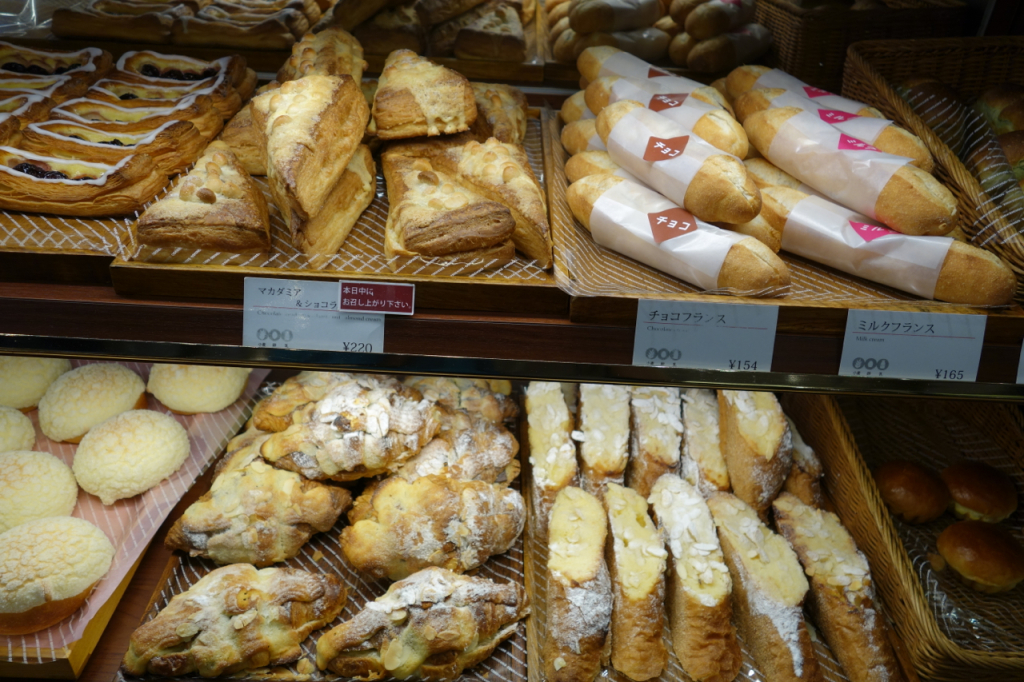
The bakery was separate from the restaurant even though they shared the same space, so if you wanted to get some pastries and sit down to enjoy them the restaurant politely requested that you buy something small such as a drink as well.

I got some pastries to go, and then we sat down to enjoy a meal. The restaurant was called Shinshindo, and the menu proclaimed, “Welcome to the Shinshindo restaurant which can eat the most delicious breakfast.” Confident statement, and I was eager to test it. The waitress brought a picture menu which was easy to order from. I just pointed to the picture of yogurt with granola and honey.

After sneaking peeks around at the other patrons I discovered what the popular dish of the morning was – small salad with scrambled eggs and potatoes. I motioned for the waitress back over, and quickly added it to my order. When the food arrived I could see why it was so popular. The salad leaves were fresh with a light dressing, the small potatoes had a crunchy, slightly salty flavor and the eggs were cooked just right. There definitely was something to the restaurant’s claim, and I agreed that it was a most delicious breakfast.
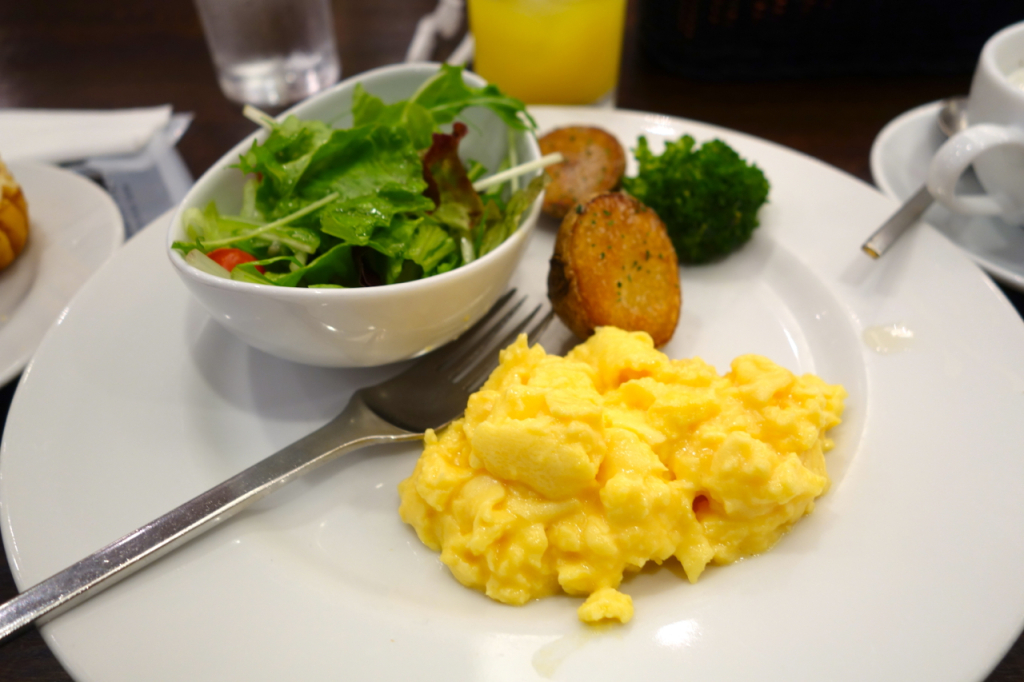
My husband ordered the Croque Madame and said it was delicious as well. We munched happily in silence for a while as other patrons did the same.
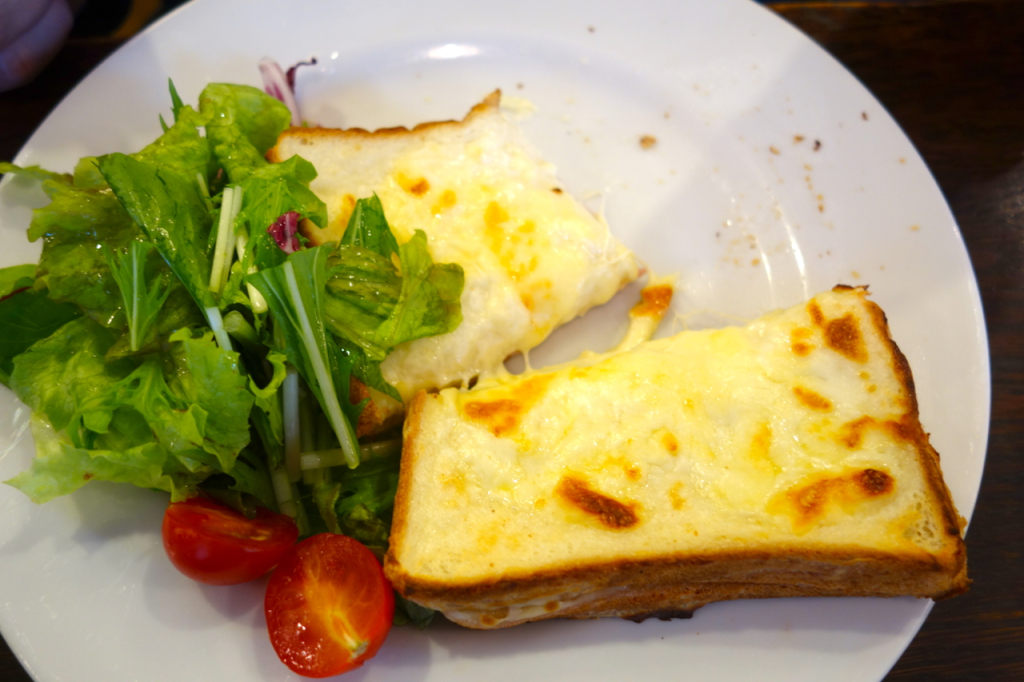
After breakfast we ventured across the street into the shopping area.
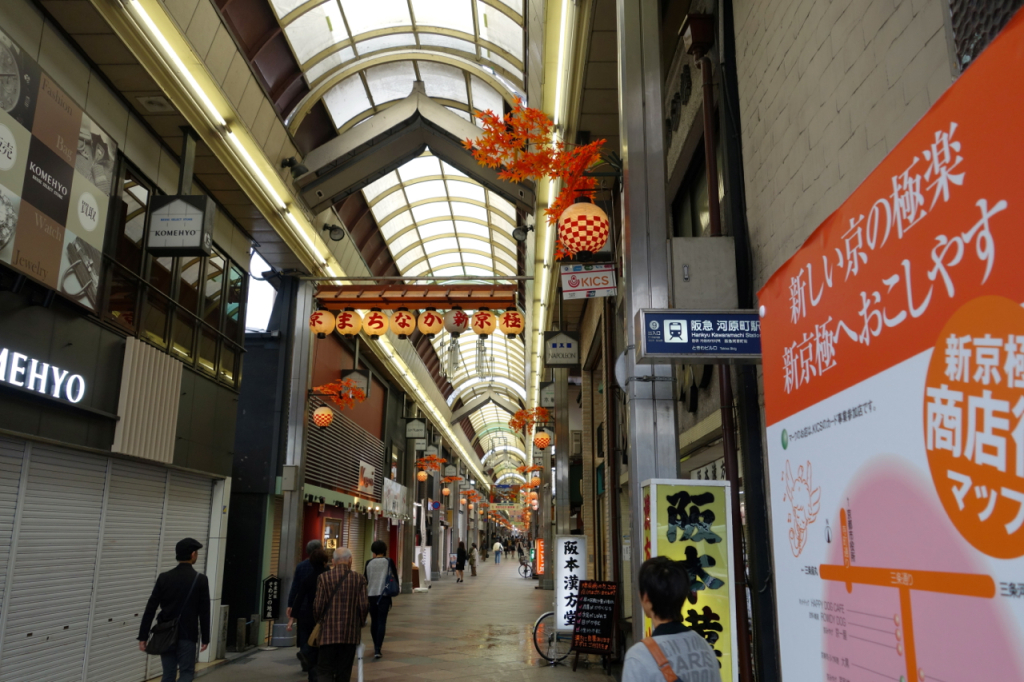
The first main street we ventured down was Shinkyogoku, which is filled with all kinds of kitchy souvenirs. Because it was still early in the morning not all the shopkeepers had their wares ready but were just starting to prepare for the day.
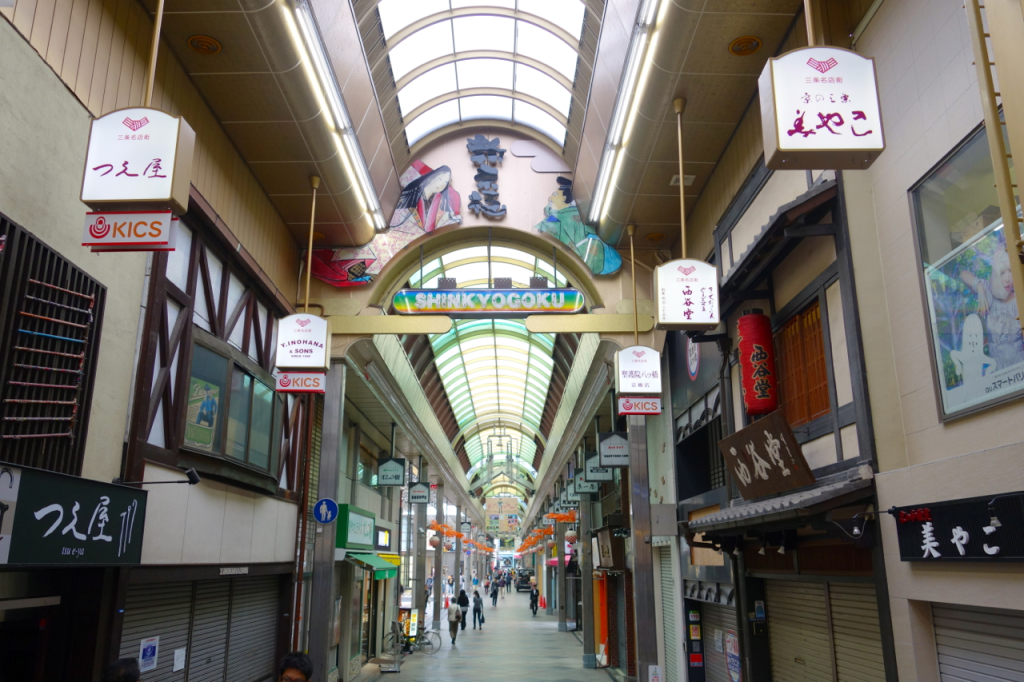
It was fun to walk around and take in the sights, and I got a kick out of looking at all the colorful signs.

Even though most of the shops were still closed, one that seemed to be an all-night affair was the arcade. Kind of like a kiddie video game arcade on steroids, the super bright lights in the arcade flashed and there were constant beeps and buzzes and clicks. Â I’m not sure how he could have done it, but I saw a man that had fallen asleep sitting up and was snoring with his mouth wide open as he leaned against a glass case. I watched as two guys bonged away on some drums nearby and stomped their shoes in a dance of sorts.
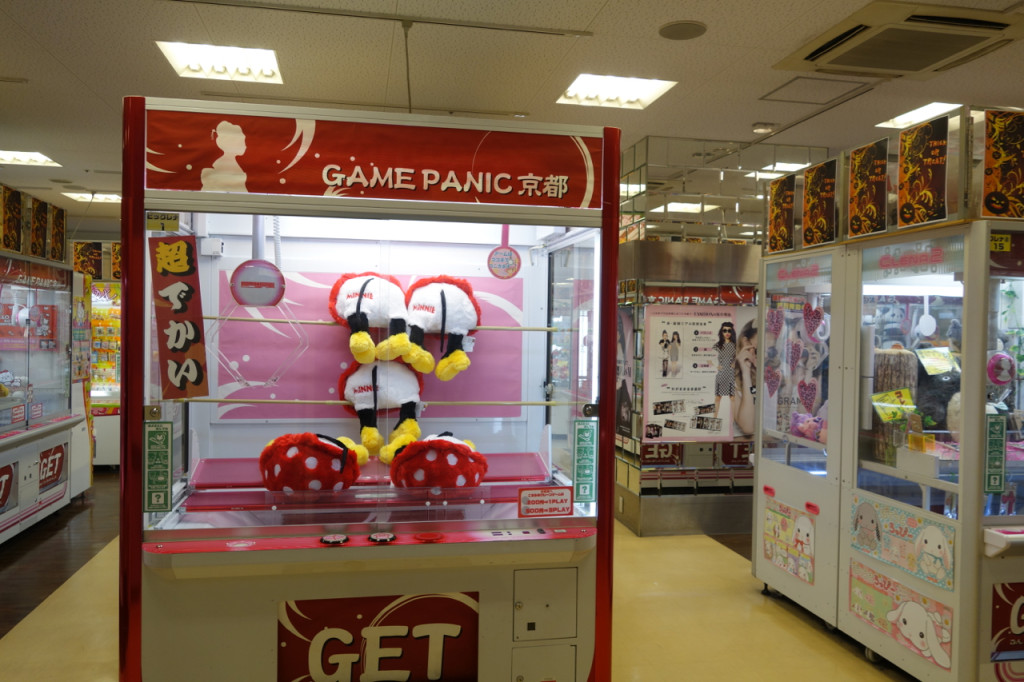
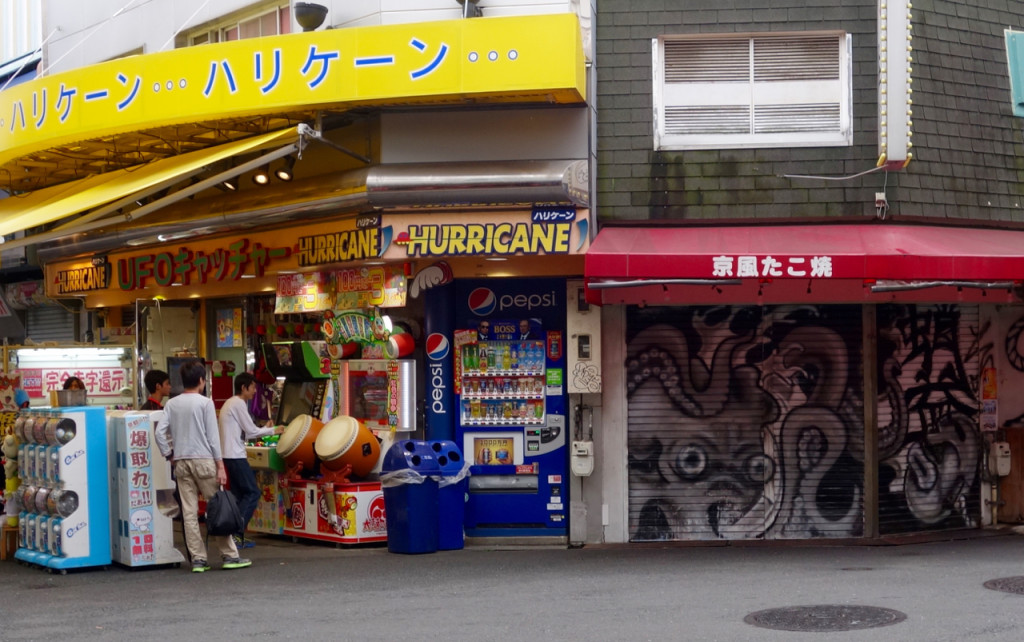
I didn’t need to be able to read the writing to know that a coffee shop was nearby, which perhaps the guys frequented throughout the early morning hours.
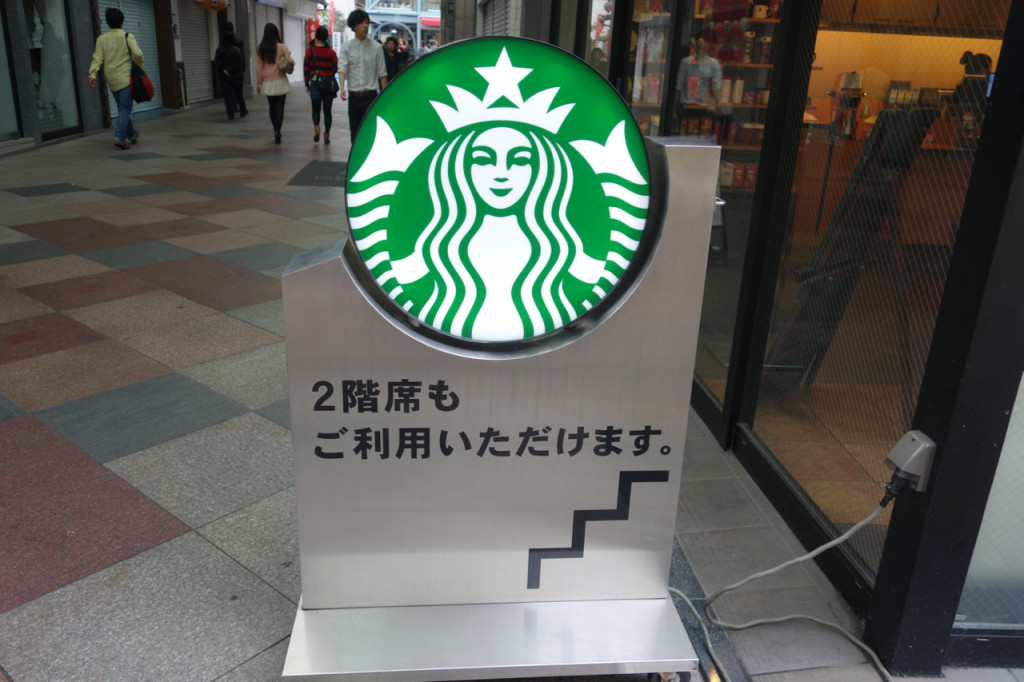
Long ago, my hometown had a Shakey’s pizza parlor and it seemed to have been resurrected in Kyoto as Shakey’s pizza and spaghetti…and potatoes and curry.

I’m sure I had a big sign on my head that screamed, “tourist!” especially when I stopped in front of London-ya. Little cakes were being made by a machine right behind the window and I stood entranced for a while. The London-yaki cakes are made with honey, eggs and sweet white bean paste.
Of course I had to buy one to take a taste. It was ok, but like many sweets in Japan it was less sweet than I had imagined.

Our walk had taken us to the Kyoto JR station where we boarded the train, heading to the Inari station just two stops away. It cost just Â¥140 (about 1 USD) and travel time couldn’t have been more than 5 or 10 minutes.
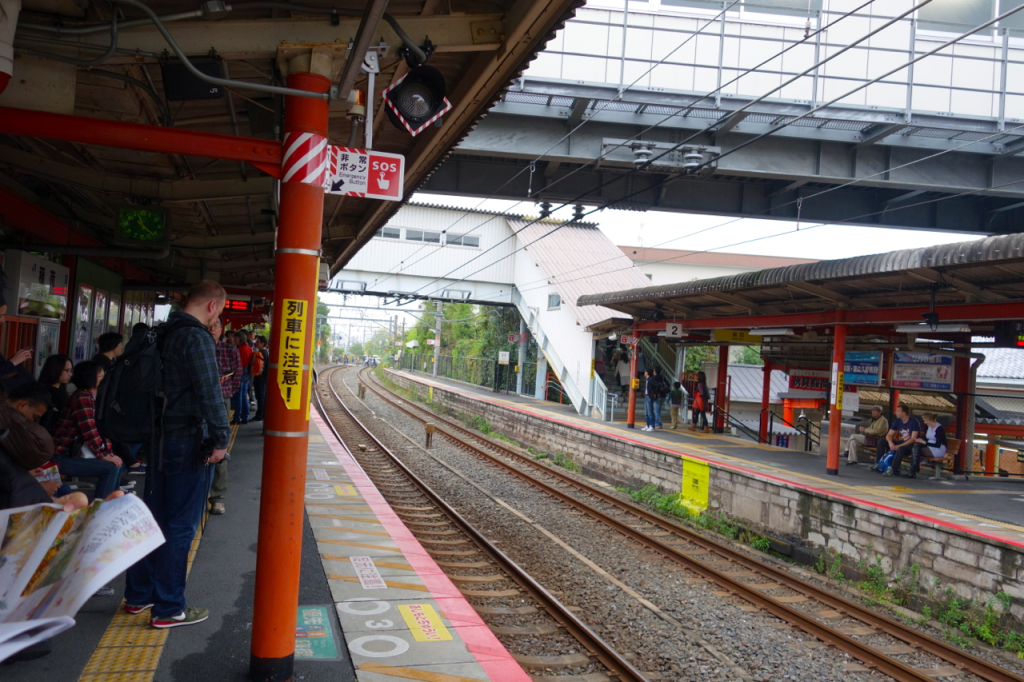
Literally across the street from the station was Fushimi-Inari-Taisha Shrine. The sacred wooden forest of Mount Inari has walking trails, and you could easily spend half a day there. Fushimi Inari is dedicated to Inari, the Shinto god of rice. Foxes are Inari’s messengers, so it seemed fitting that the first statues we came across were proud foxes.


Since we were in Kyoto, it was pretty neat to see Geisha walking around in their traditional geta. I can’t imagine the footwear is very comfortable though for an extended period of time. (edit: reader Penguin pointed out that the women are not Geisha but dressed in kimonos)
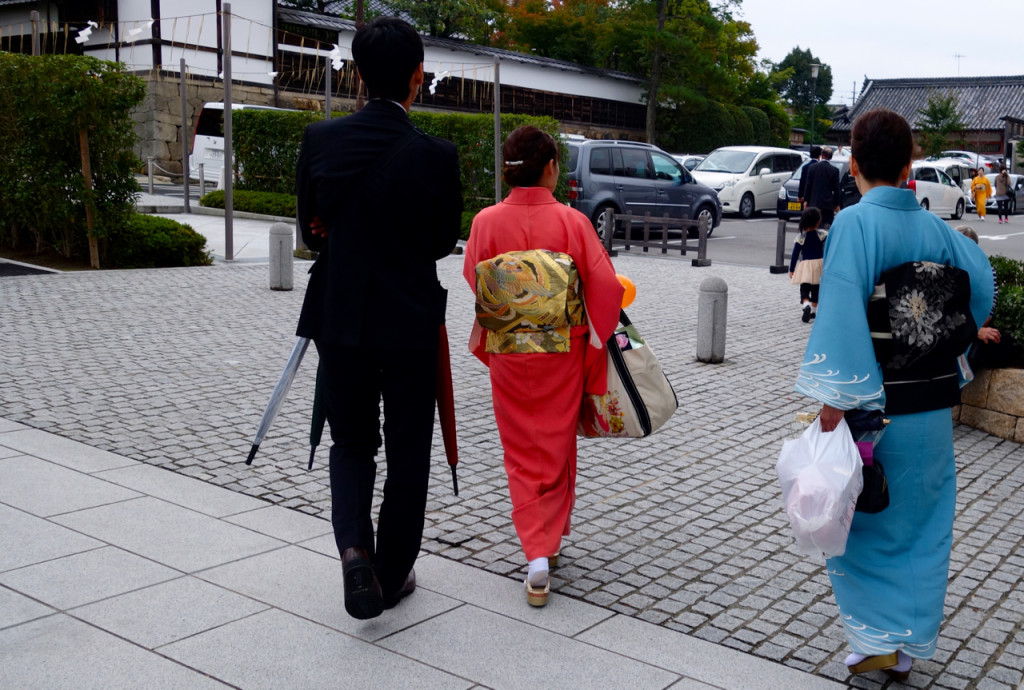
I didn’t think men wore geta, but I saw a man wearing socks with shoes that looked suspiciously similar.
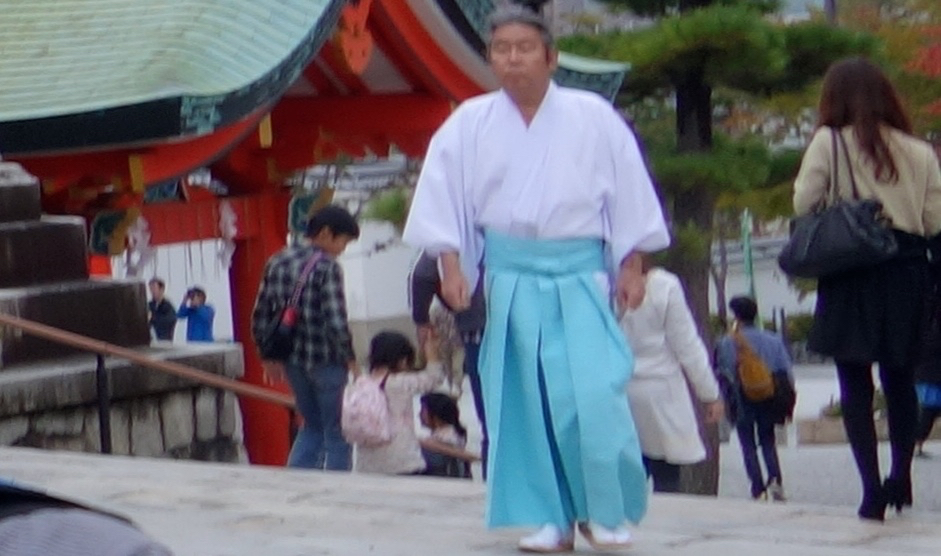
The huge torii gate welcomed guests to the entrance. The man on the left was showing respect by bowing before entering the main Torii Gate, which all guests are requested to do.
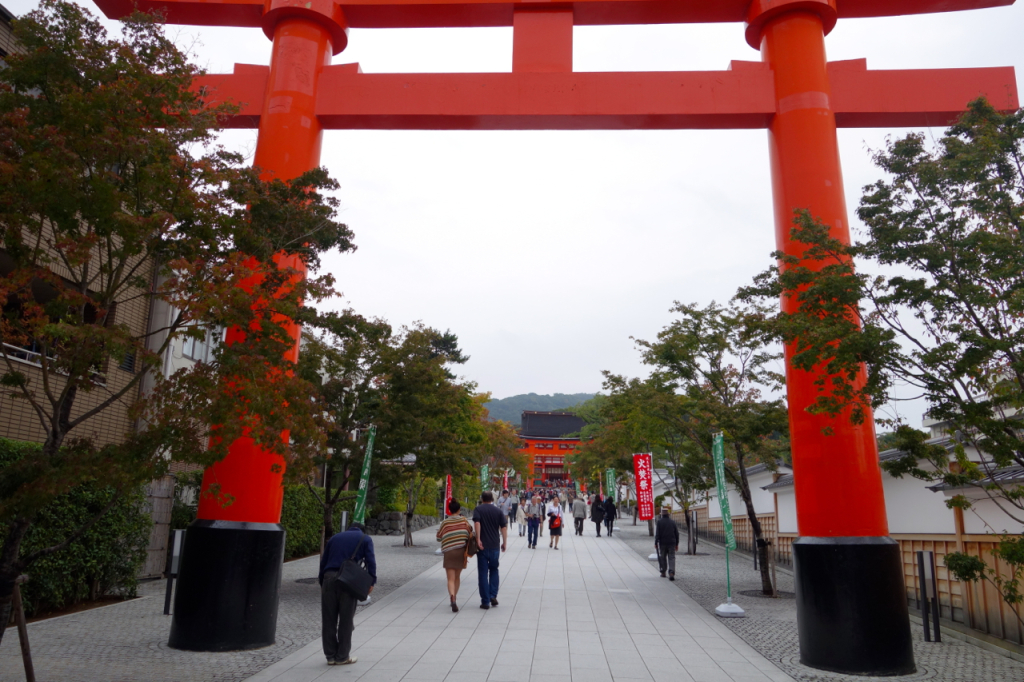
As far as I know there is no opening or closing time so you can come whenever you like, and if you go in hotter weather make sure to bring some water with you if planning to hike for a while.
There is a proper way to show respect when visiting the shrine. First you bow twice, make a wish, clap twice and bow again. I believe the last bow is supposed to be lower than the first two. You might see other tourists clapping a bunch and doing a bunch of bows, or maybe that was just me like I did the first time I visited a Shrine in Japan. I didn’t know the proper way to show respect so I tried to copy what everyone else was doing.
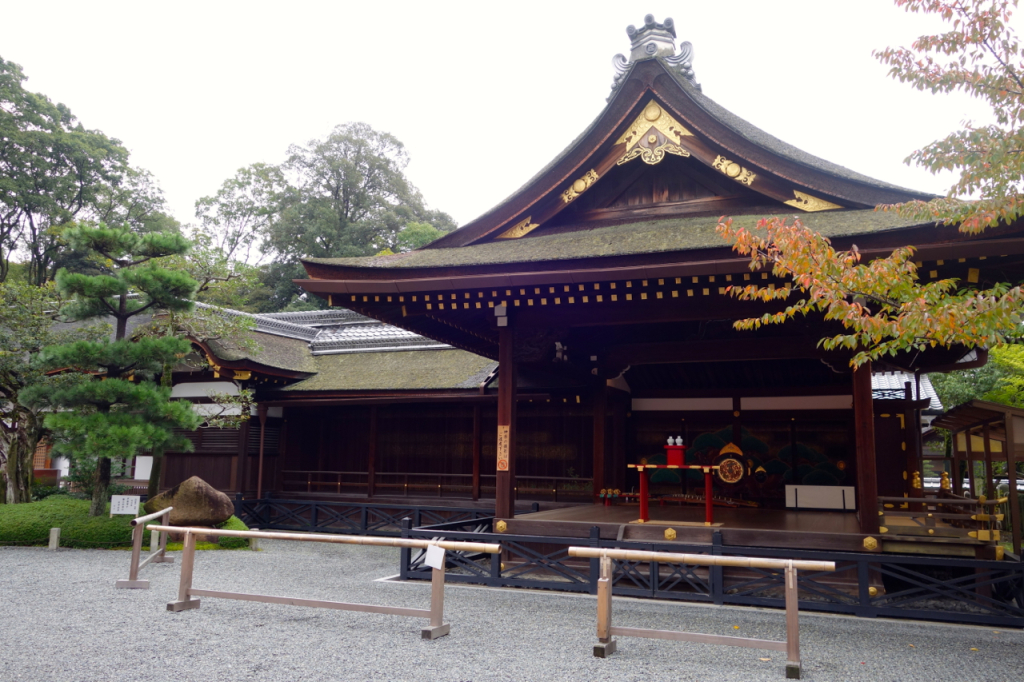
Even more mysterious to me was the water place, which you visit before the main shrine. Even though it might appear that people are randomly scooping the water up and drinking it, there is actually a specific order to do everything in. First you hold the scoop in your right hand and pour water on your left hand to clean it. Then you switch hands so you are holding the scoop in your left and pouring over your right hand. Finally, switch back again, pour water on your left hand and use it to wash your mouth. I don’t think you are supposed to wash your mouth directly from the scoop but I saw plenty of people doing it so maybe it varies depending on location or personal belief.
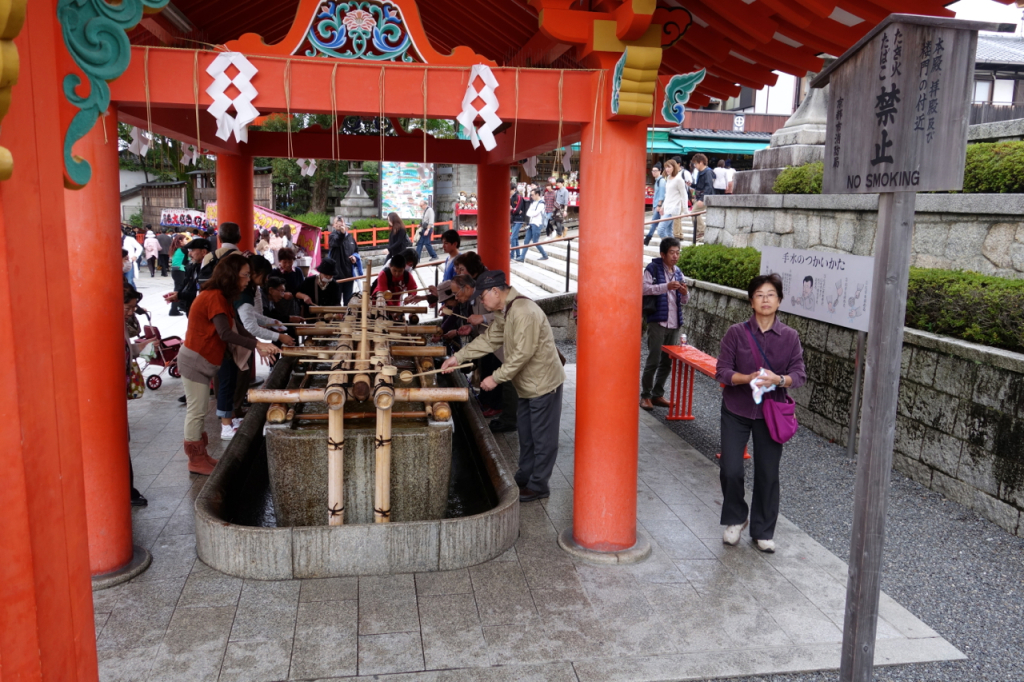
There were two separate rows of torii gates, and I found that foot traffic typically moved down one set and went back up the other way. Each of the brightly colored gates is donated by a person or company, and their name and the date donated is etched right in the torii.
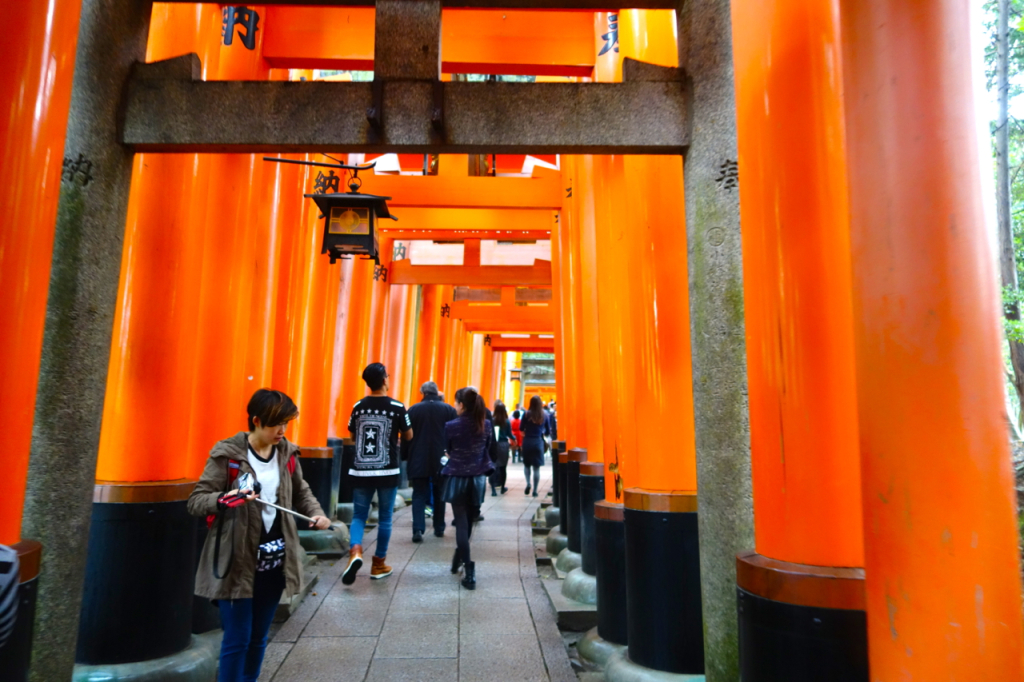
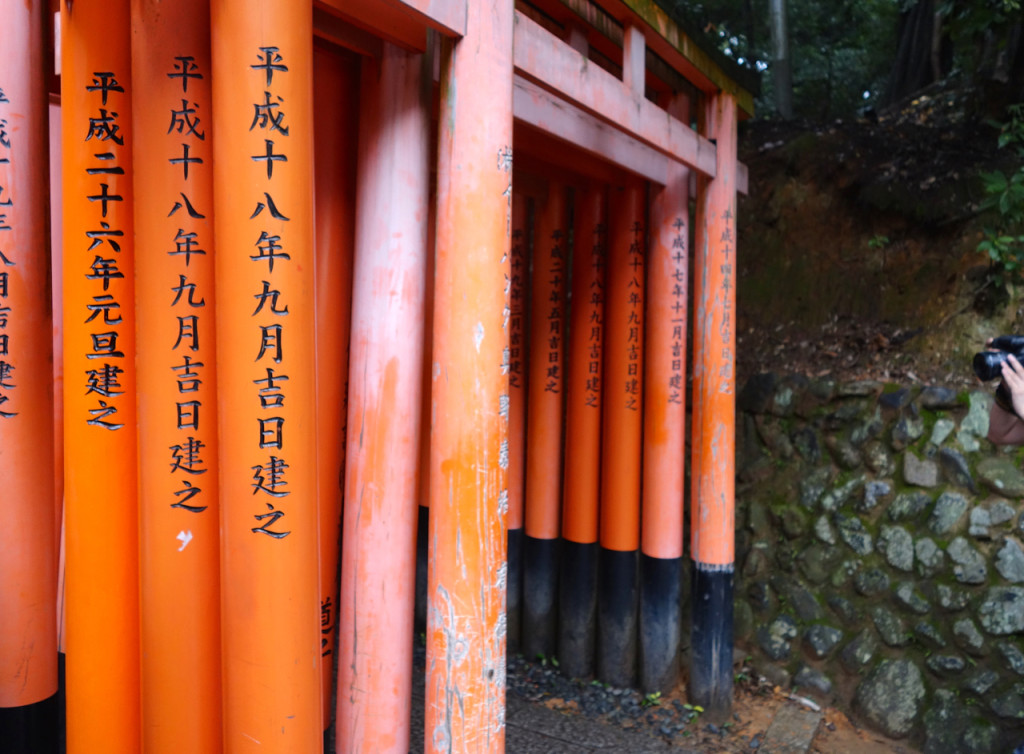
It was cool and misty, and people walked quietly through the torii, stopping to take selfies and pictures of their friends making peace symbols with their fingers. Tweet-tweet-tweet-tweet called a bird softly in the distance, and there was something calming about following the winding paths.
Thousands of torii gates dotted the hillside. The entire loop of gates would have taken around 3 hours, but we got to Yotsutsuji intersection in about 30 minutes. Along the path there were some restaurants and smaller shrines too. You could stop at any time and turn around, so you could plan according to your timeframe and fitness level.
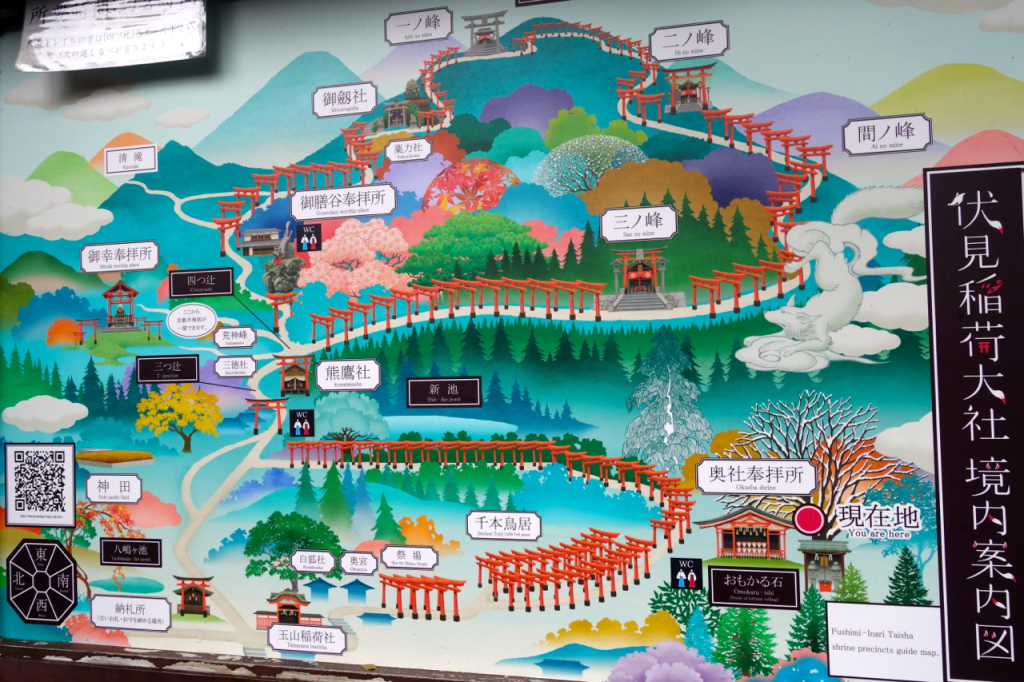
After we’d had our fill we headed back down to the train station, passing souvenir shops filled with trinkets such that would make good Christmas stocking stuffers.

Back at the train station we had just gotten to the correct platform when the skies suddenly opened up and the misty morning turned into a rainy downpour. Perfect timing, especially since neither one of us had brought an umbrella. We listened to the pitter-patter of the rain on the metal roof and watched as a few trains went by.

In the distance, there was a parade of umbrellas as people made their way across the tracks.
Our train arrived, packed with people. We got on and headed back to the hotel.
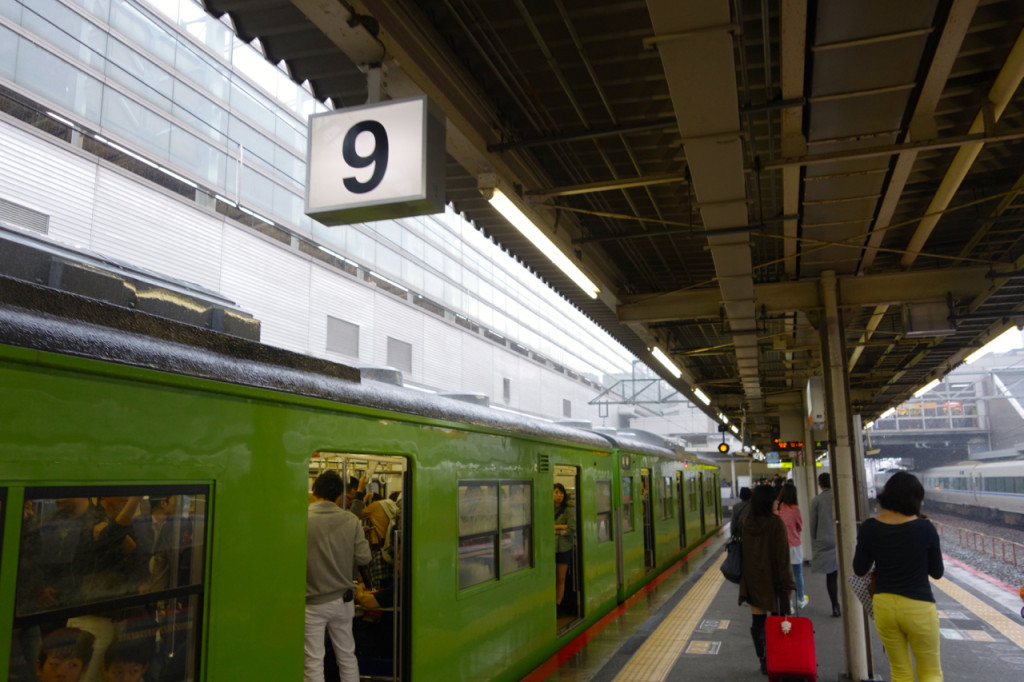
Perhaps because we had started out early in the morning, there hadn’t been a lot of crowds. It had been a wonderful day, not full with a ton of items to check off but a simple leisurely itinerary. I loved the breakfast, the walk, the torii gates and now looked forward to planning out another day in Kyoto.
Next up: Day 2 in Kyoto

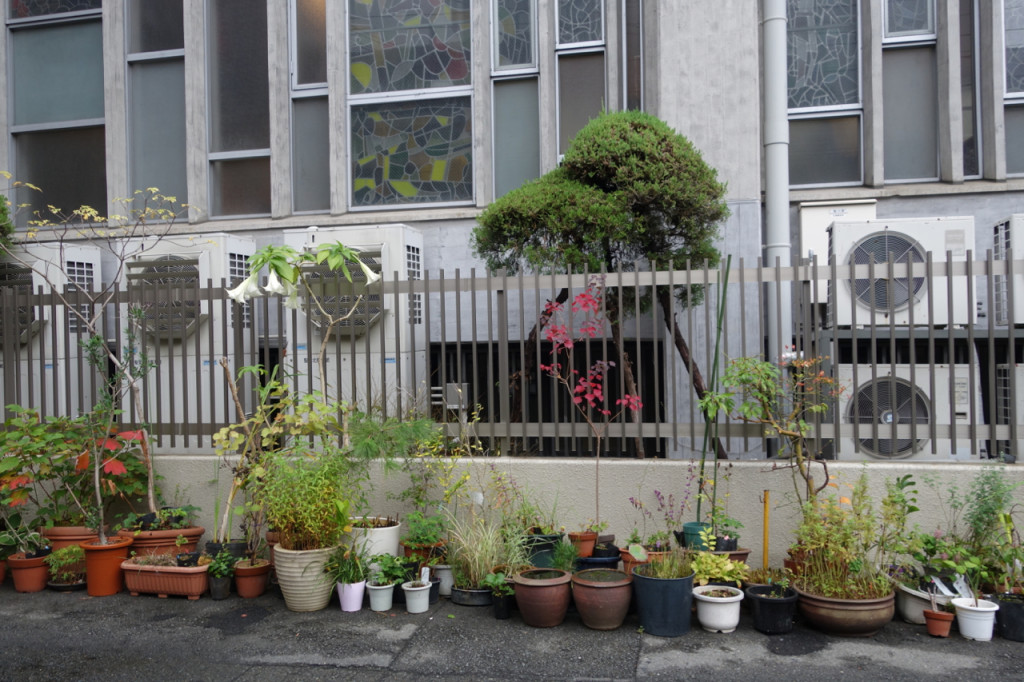
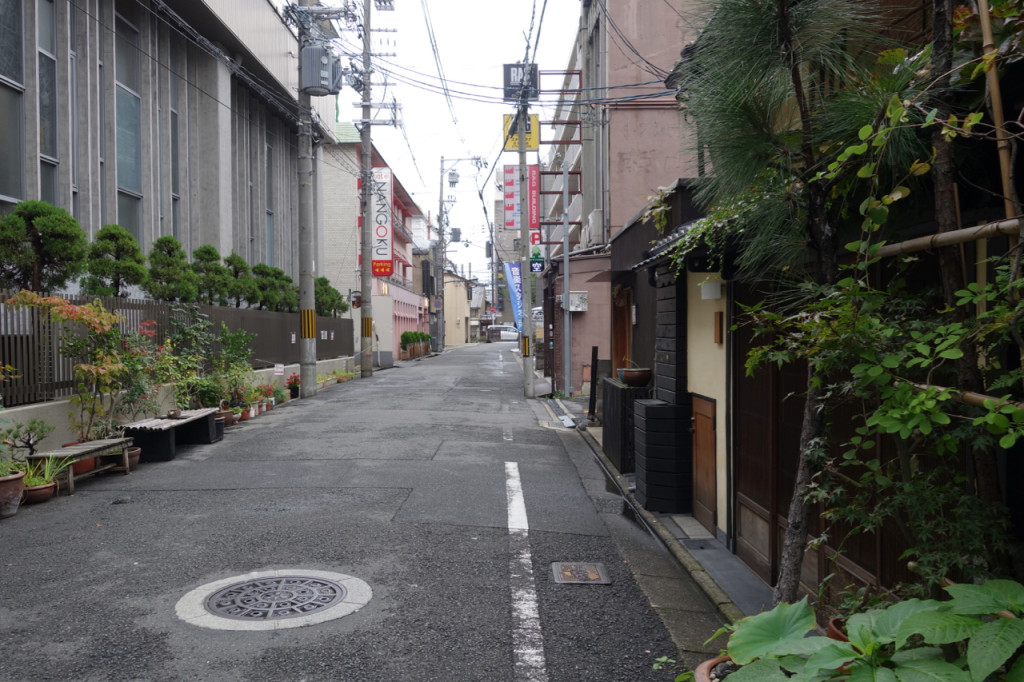
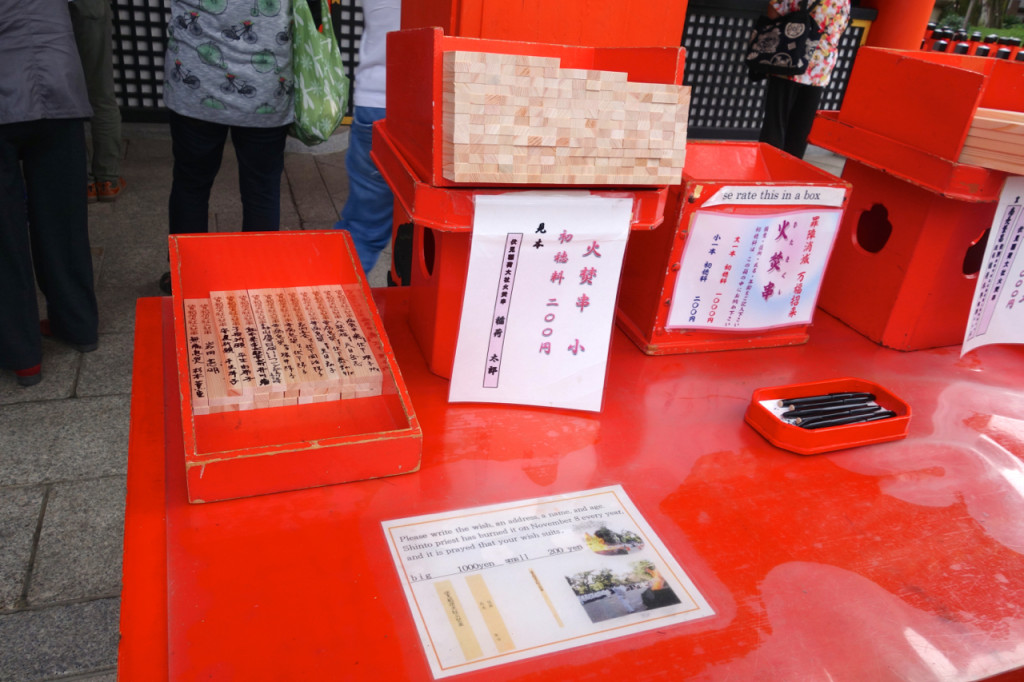
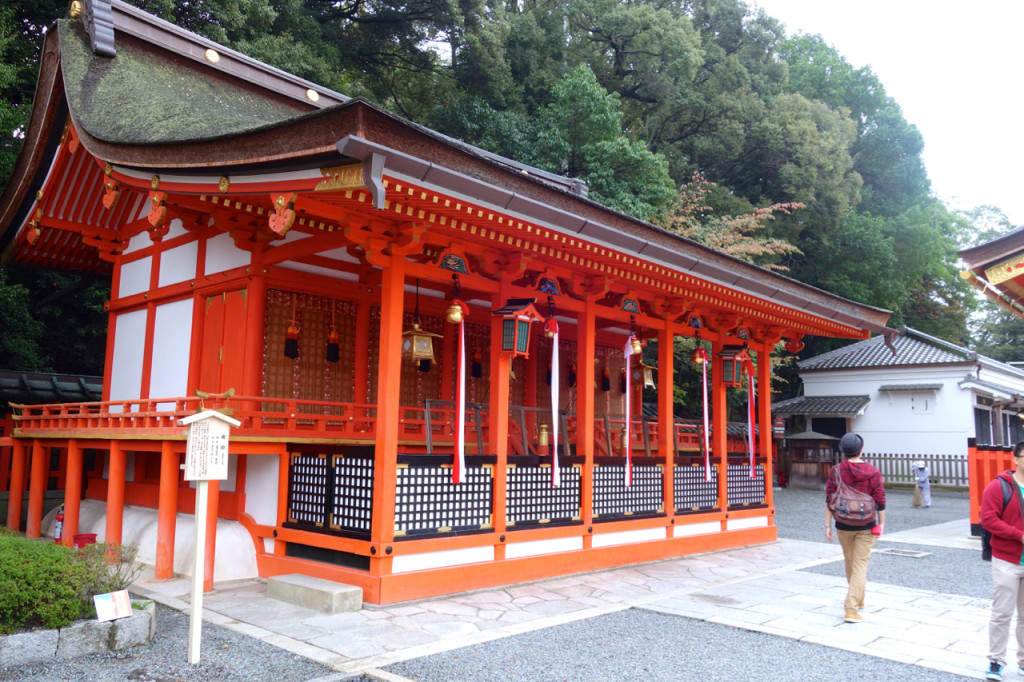

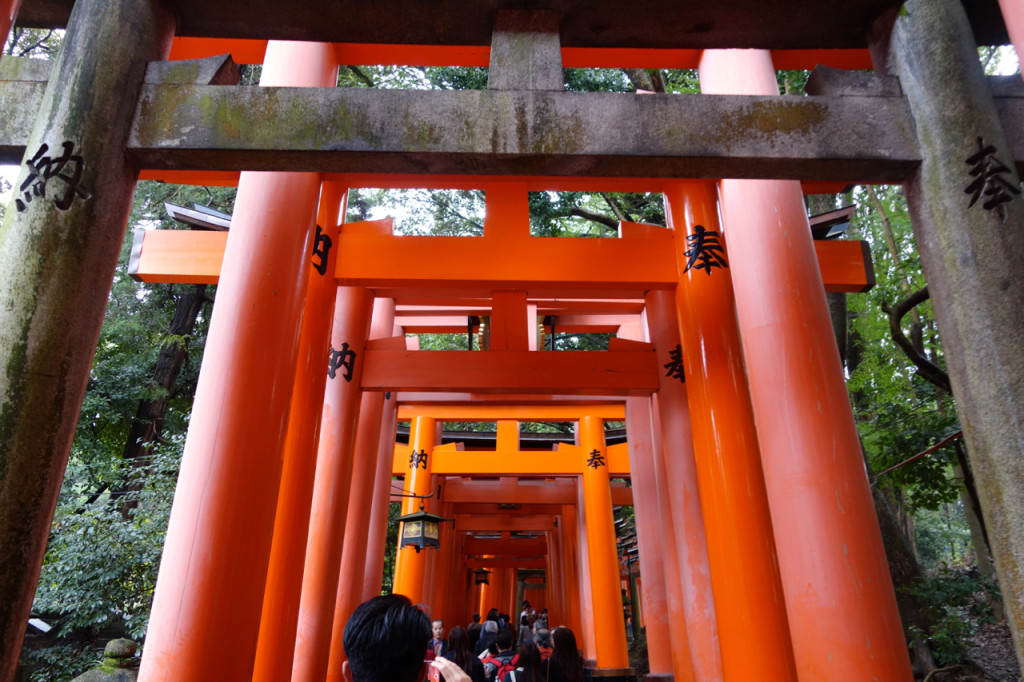

Hi Melinda,
Enjoyed the report. We loved our trip to Japan. If anyone is interested Geisha are found in the Gion district of Kyoto and usually around dusk when they are heading to their appointments. Walk the back and side streets and you’ll find them. I managed to photograph about 4 of them – very lucky timing.
SW I’m sure many readers find Geisha intriguing, thanks for the helpful hint for shutterbugs. You were indeed fortunate to get some good photos. Thanks for reading!
Perfect trip report for our trip coming up this Fall. Is there a train station within walking distance of the Ritz?
SonomaWine, there is the Kyoto Shiyakusho-mae Station of Subway Tozai Line which is 3 minutes, Sanjo Station of Keihan Line which is about 5, and then there’s Kyoto Station. If you take it easy you can walk there in about 45 minutes but taxi would take about 15. Thanks for reading!
Hi Melinda,
I’m glad you had fun in Kyoto; please excuse a passer-by Japanese leaving some comments to add some context 🙂
The women in the “Geisha” pic are not Geisha; they are dressed in a simple kimono and probably attending or staffing a social event. Geishas will have much more elaborate kimonos and heavy, white make up with decorative hair. Seeing Geishas in public in Kyoto is very rare, but ordinary people will often wear kimonos to formal events. Many shops and tourist venues have staff dress in kimonos, too.
The man in white shirt and blue pants is wearing “waraji”; sandals made of straw. Male shrine staff at Fushimi wear this uniform, even if they are part time workers staffing shops. “Geta” wooden sandals may look difficult to walk in but they’re actually pretty easy to get used compared to high heels.
As for the water scoops in front of shrines and temples, the proper way to cleanse yourself used to be to take scoops to your mouth directly, but the official directions have been modified for sanitary reasons. Many older people will still scoop to their mouth directly, whereas younger ones will skip the cleansing altogether. The cleansing and worship directions can be pretty different depending on the shrine/temple, but only the most religious or cultured will follow them strictly.
I hope the weather was nicer the rest of your trip, although misty Kyoto in a wooden umbrella might be pretty fun, too.
Wonderful clarification and I appreciate your comments, thanks Penguin! 🙂 I had been curious and this saves me from googling “do men wear geta?” along with similar questions. Thanks for reading!
Great report. We are heading to Kyoto next week and you’ve given us a few activities and breakfast items to try!
I’m excited for you SAN Greg, and thanks for reading!